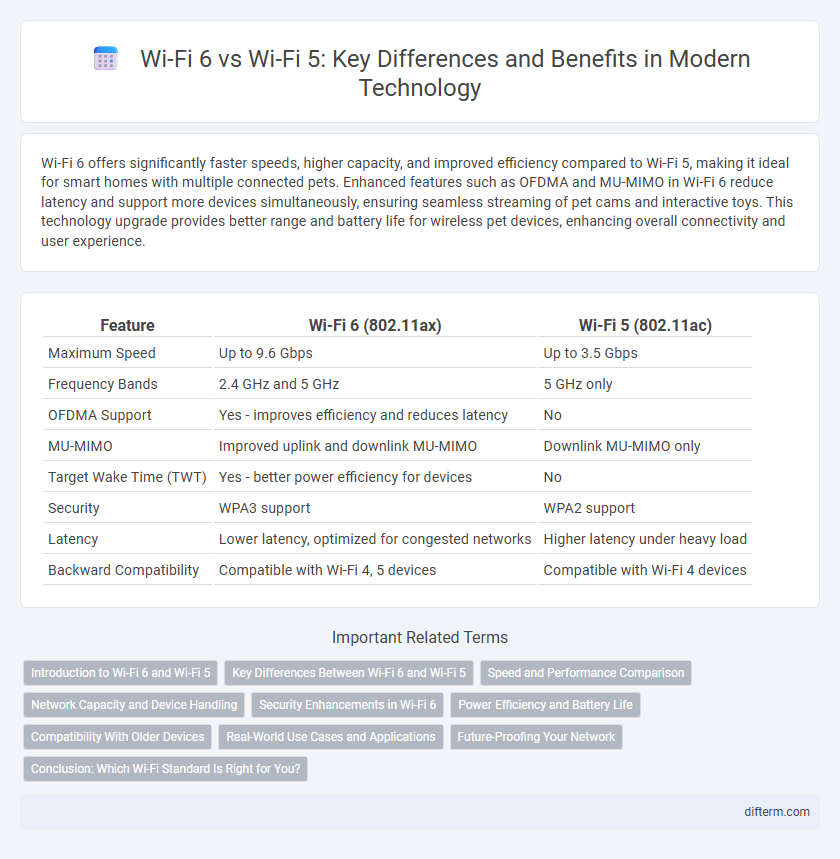Wi-Fi 6 offers significantly faster speeds, higher capacity, and improved efficiency compared to Wi-Fi 5, making it ideal for smart homes with multiple connected pets. Enhanced features such as OFDMA and MU-MIMO in Wi-Fi 6 reduce latency and support more devices simultaneously, ensuring seamless streaming of pet cams and interactive toys. This technology upgrade provides better range and battery life for wireless pet devices, enhancing overall connectivity and user experience.
Table of Comparison
| Feature | Wi-Fi 6 (802.11ax) | Wi-Fi 5 (802.11ac) |
|---|---|---|
| Maximum Speed | Up to 9.6 Gbps | Up to 3.5 Gbps |
| Frequency Bands | 2.4 GHz and 5 GHz | 5 GHz only |
| OFDMA Support | Yes - improves efficiency and reduces latency | No |
| MU-MIMO | Improved uplink and downlink MU-MIMO | Downlink MU-MIMO only |
| Target Wake Time (TWT) | Yes - better power efficiency for devices | No |
| Security | WPA3 support | WPA2 support |
| Latency | Lower latency, optimized for congested networks | Higher latency under heavy load |
| Backward Compatibility | Compatible with Wi-Fi 4, 5 devices | Compatible with Wi-Fi 4 devices |
Introduction to Wi-Fi 6 and Wi-Fi 5
Wi-Fi 6, also known as 802.11ax, offers significant advancements over Wi-Fi 5 (802.11ac) by delivering faster speeds, higher capacity, and improved performance in congested environments. Wi-Fi 6 introduces technologies like OFDMA and MU-MIMO that enhance data efficiency and reduce latency, making it ideal for modern smart homes and IoT devices. In contrast, Wi-Fi 5 provided faster speeds than its predecessors but lacks the enhanced network management features and energy efficiency improvements found in Wi-Fi 6.
Key Differences Between Wi-Fi 6 and Wi-Fi 5
Wi-Fi 6 offers up to 9.6 Gbps maximum data rate compared to Wi-Fi 5's 3.5 Gbps, significantly enhancing speed and capacity for multiple devices. It introduces Orthogonal Frequency Division Multiple Access (OFDMA) and Target Wake Time (TWT) technologies, which improve network efficiency and battery life, unlike Wi-Fi 5. Advanced features such as MU-MIMO with increased streams support and improved security protocols like WPA3 further distinguish Wi-Fi 6 from its predecessor.
Speed and Performance Comparison
Wi-Fi 6 delivers significantly faster speeds, achieving up to 9.6 Gbps compared to Wi-Fi 5's maximum of 3.5 Gbps, enhancing overall network throughput. The introduction of OFDMA and MU-MIMO technologies in Wi-Fi 6 improves efficiency and reduces latency, especially in dense environments with multiple connected devices. This results in more stable connections and better performance for bandwidth-intensive applications such as gaming, streaming, and virtual reality.
Network Capacity and Device Handling
Wi-Fi 6 offers significantly higher network capacity compared to Wi-Fi 5, supporting up to four times more devices simultaneously due to advanced OFDMA technology. This improvement reduces latency and increases efficiency in environments with dense device connectivity, such as offices and smart homes. Enhanced MU-MIMO capabilities in Wi-Fi 6 also enable better data handling and improved overall network performance in multi-user scenarios.
Security Enhancements in Wi-Fi 6
Wi-Fi 6 introduces WPA3 encryption, offering stronger protection against brute-force attacks compared to Wi-Fi 5's WPA2. Enhanced security protocols in Wi-Fi 6 include individualized data encryption for improved privacy on open networks. These advancements significantly reduce vulnerabilities, making Wi-Fi 6 networks more resilient against modern cyber threats.
Power Efficiency and Battery Life
Wi-Fi 6 introduces Target Wake Time (TWT) technology, significantly improving power efficiency by scheduling device wake periods and reducing unnecessary energy consumption. This enhancement extends battery life for connected devices, especially in IoT and mobile applications. Compared to Wi-Fi 5, Wi-Fi 6 reduces latency and power drain, enabling longer operational times on battery-powered devices.
Compatibility With Older Devices
Wi-Fi 6 offers backward compatibility with Wi-Fi 5 and earlier standards, ensuring older devices can still connect without disruption. However, Wi-Fi 6 enhances network efficiency and performance by optimizing data transmission for newer devices while maintaining support for legacy equipment. This compatibility enables seamless integration in mixed-network environments, providing consistent connectivity across diverse device generations.
Real-World Use Cases and Applications
Wi-Fi 6 delivers enhanced performance in dense environments like stadiums, airports, and smart homes by supporting more simultaneous connections with improved efficiency and lower latency compared to Wi-Fi 5. Its advanced features such as OFDMA, MU-MIMO, and Target Wake Time optimize bandwidth allocation, making it ideal for video streaming, online gaming, and IoT device connectivity in real-world applications. Businesses and consumers benefit from faster data rates, better battery life for connected devices, and more reliable networks in crowded public and private settings.
Future-Proofing Your Network
Wi-Fi 6 offers enhanced future-proofing by supporting higher device density and faster speeds up to 9.6 Gbps, compared to Wi-Fi 5's 3.5 Gbps, ensuring networks can handle evolving smart home and IoT device demands. Its advanced OFDMA and MU-MIMO technologies reduce latency and improve efficiency in congested environments, making it ideal for upcoming connected ecosystems. Investing in Wi-Fi 6 guarantees better network performance and compatibility with emerging technologies over the next decade.
Conclusion: Which Wi-Fi Standard Is Right for You?
Wi-Fi 6 offers faster speeds up to 9.6 Gbps, improved efficiency, and better performance in crowded environments compared to Wi-Fi 5's 3.5 Gbps maximum. Devices requiring low latency, enhanced battery life, or operating in dense areas benefit most from Wi-Fi 6. For basic internet use and compatibility with older hardware, Wi-Fi 5 remains a cost-effective solution.
Wi-Fi 6 vs Wi-Fi 5 Infographic

 difterm.com
difterm.com